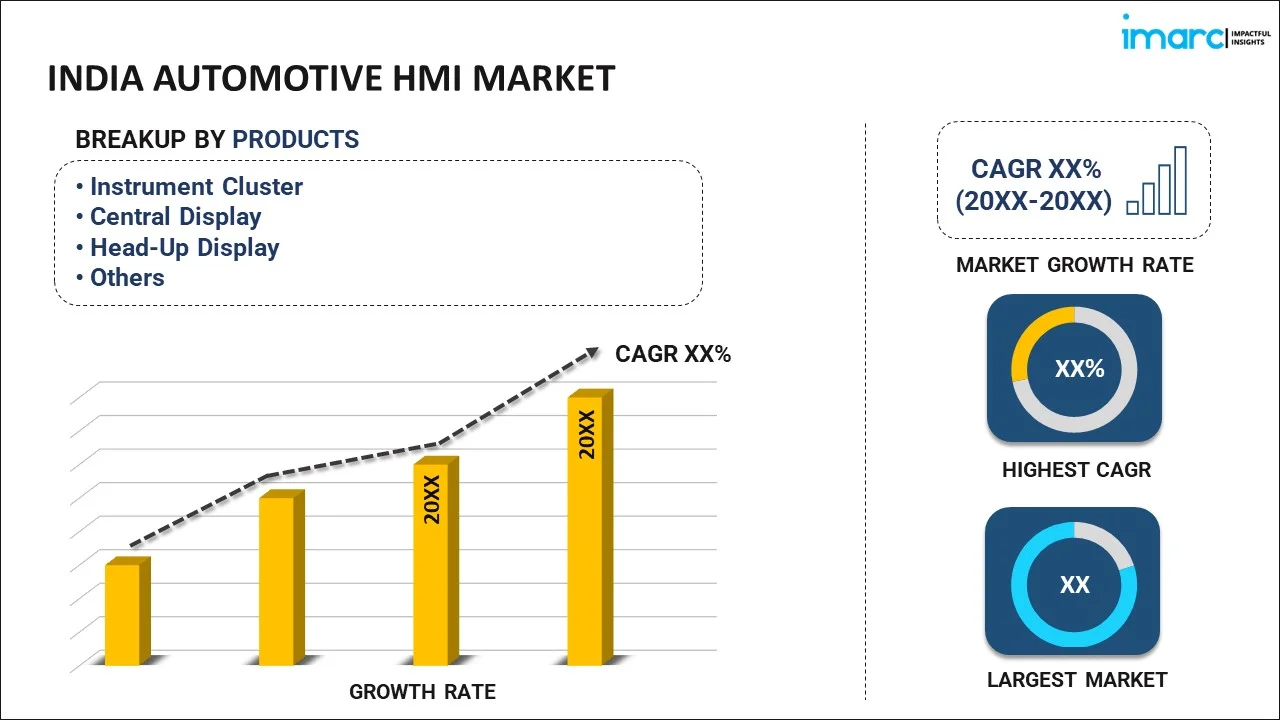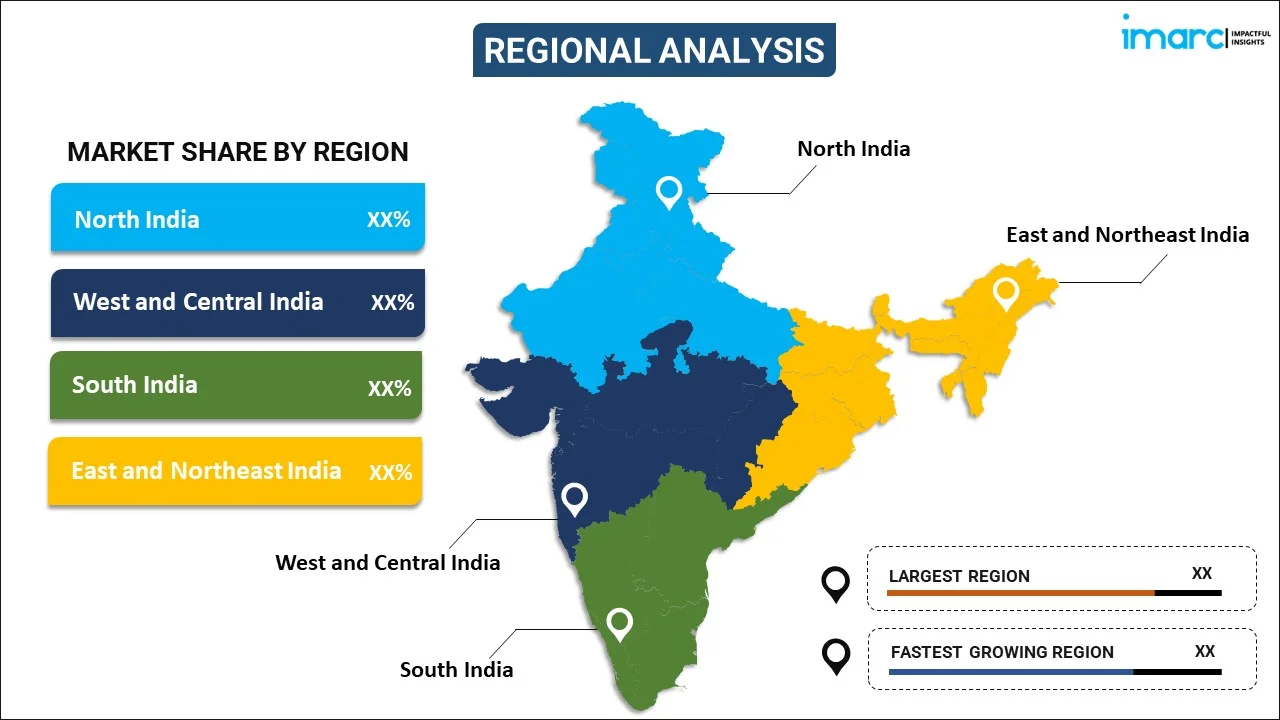
India Automotive HMI Market Report by Product (Instrument Cluster, Central Display, Head-Up Display, and Others), Access Type (Standard, Multimodal), Technology (Visual Interface, Acoustic, Mechanical, and Others), Vehicle Type (Passenger Cars, Commercial Vehicles), and Region 2025-2033
Market Overview:
India automotive HMI market size is projected to exhibit a growth rate (CAGR) of 13.68% during 2025-2033. The increasing adoption of ADAS technologies, including features like lane departure warning, adaptive cruise control, and automated parking, which has led to the need for more sophisticated and user-friendly HMIs, is driving the market.
|
Report Attribute
|
Key Statistics
|
|---|---|
|
Base Year
|
2024 |
|
Forecast Years
|
2025-2033 |
|
Historical Years
|
2019-2024
|
| Market Growth Rate (2025-2033) | 13.68% |
Automotive human-machine interface (HMI) refers to the technology that enables communication and interaction between a vehicle's users and its internal systems. It encompasses the graphical and tactile elements through which drivers and passengers engage with the vehicle's controls and receive information. Common components of automotive HMI include touchscreens, voice recognition, physical buttons, and gesture controls. The primary goal is to create an intuitive and user-friendly interface that enhances safety, convenience, and overall driving experience. Modern automotive HMIs integrate advanced technologies, such as augmented reality and artificial intelligence, to provide real-time information, navigation assistance, and seamless connectivity with smartphones and other devices. As vehicles evolve towards increased automation, HMI becomes a critical aspect in ensuring effective communication between humans and autonomous or semi-autonomous driving systems.
India Automotive HMI Market Trends:
The automotive HMI market in India is experiencing robust growth, propelled by several key drivers. Firstly, the escalating demand for connected and autonomous vehicles has significantly contributed to the expansion of the HMI market. As vehicles become more sophisticated and integrated with advanced technologies, the need for intuitive and user-friendly interfaces becomes paramount. Additionally, the increasing focus on enhancing the overall driving experience and safety features has driven the adoption of advanced HMIs in automobiles. Moreover, the proliferation of electric vehicles (EVs) has played a pivotal role in the surging demand for innovative HMI solutions. The unique requirements of electric vehicles, such as real-time battery monitoring and energy consumption data, necessitate sophisticated HMI designs. Furthermore, the integration of augmented reality (AR) and virtual reality (VR) technologies in automotive displays has become a pivotal driver. These technologies not only offer enhanced driver assistance but also contribute to creating immersive in-car experiences. Furthermore, the rise of the Internet of Things (IoT) has led to increased connectivity within vehicles, fostering the demand for HMI systems that seamlessly integrate with other smart devices. In conclusion, the automotive HMI market in India is propelled by a confluence of factors, including the demand for connected and autonomous vehicles, the surge in EVs, the integration of AR and VR technologies, and the growing influence of IoT in the automotive sector.
India Automotive HMI Market Segmentation:
IMARC Group provides an analysis of the key trends in each segment of the market, along with forecasts at the country level for 2025-2033. Our report has categorized the market based on product, access type, technology, and vehicle type.
Product Insights:

- Instrument Cluster
- Central Display
- Head-Up Display
- Others
The report has provided a detailed breakup and analysis of the market based on the product. This includes instrument cluster, central display, head-up display, and others.
Access Type Insights:
- Standard
- Multimodal
A detailed breakup and analysis of the market based on the access type have also been provided in the report. This includes standard and multimodal.
Technology Insights:
- Visual Interface
- Acoustic
- Mechanical
- Others
The report has provided a detailed breakup and analysis of the market based on the technology. This includes visual interface, acoustic, mechanical, and others.
Vehicle Type Insights:
- Passenger Cars
- Commercial Vehicles
A detailed breakup and analysis of the market based on the vehicle type have also been provided in the report. This includes passenger cars and commercial vehicles.
Regional Insights:

- North India
- West and Central India
- South India
- East and Northeast India
The report has also provided a comprehensive analysis of all the major regional markets, which include North India, West and Central India, South India, and East and Northeast India.
Competitive Landscape:
The market research report has also provided a comprehensive analysis of the competitive landscape. Competitive analysis such as market structure, key player positioning, top winning strategies, competitive dashboard, and company evaluation quadrant has been covered in the report. Also, detailed profiles of all major companies have been provided.
India Automotive HMI Market Report Coverage:
| Report Features | Details |
|---|---|
| Base Year of the Analysis | 2024 |
| Historical Period | 2019-2024 |
| Forecast Period | 2025-2033 |
| Units | Million USD |
| Scope of the Report | Exploration of Historical Trends and Market Outlook, Industry Catalysts and Challenges, Segment-Wise Historical and Future Market Assessment:
|
| Products Covered | Instrument Cluster, Central Display, Head-Up Display, Others |
| Access Types Covered | Standard, Multimodal |
| Technologies Covered | Visual Interface, Acoustic, Mechanical, Others |
| Vehicle Types Covered | Passenger Cars, Commercial Vehicles |
| Regions Covered | North India, West and Central India, South India, East and Northeast India |
| Customization Scope | 10% Free Customization |
| Post-Sale Analyst Support | 10-12 Weeks |
| Delivery Format | PDF and Excel through Email (We can also provide the editable version of the report in PPT/Word format on special request) |
Key Questions Answered in This Report:
- How has the India automotive HMI market performed so far and how will it perform in the coming years?
- What has been the impact of COVID-19 on the India automotive HMI market?
- What is the breakup of the India automotive HMI market on the basis of product?
- What is the breakup of the India automotive HMI market on the basis of access type?
- What is the breakup of the India automotive HMI market on the basis of technology?
- What is the breakup of the India automotive HMI market on the basis of vehicle type?
- What are the various stages in the value chain of the India automotive HMI market?
- What are the key driving factors and challenges in the India automotive HMI?
- What is the structure of the India automotive HMI market and who are the key players?
- What is the degree of competition in the India automotive HMI market?
Key Benefits for Stakeholders:
- IMARC’s industry report offers a comprehensive quantitative analysis of various market segments, historical and current market trends, market forecasts, and dynamics of the India automotive HMI market from 2019-2033.
- The research report provides the latest information on the market drivers, challenges, and opportunities in the India automotive HMI market.
- Porter's five forces analysis assist stakeholders in assessing the impact of new entrants, competitive rivalry, supplier power, buyer power, and the threat of substitution. It helps stakeholders to analyze the level of competition within the India automotive HMI industry and its attractiveness.
- Competitive landscape allows stakeholders to understand their competitive environment and provides an insight into the current positions of key players in the market.
Need more help?
- Speak to our experienced analysts for insights on the current market scenarios.
- Include additional segments and countries to customize the report as per your requirement.
- Gain an unparalleled competitive advantage in your domain by understanding how to utilize the report and positively impacting your operations and revenue.
- For further assistance, please connect with our analysts.
 Inquire Before Buying
Inquire Before Buying
 Speak to an Analyst
Speak to an Analyst
 Request Brochure
Request Brochure
 Request Customization
Request Customization




.webp)




.webp)












